Want to Help the Gulf of Mexico? Kill Your Lawn.
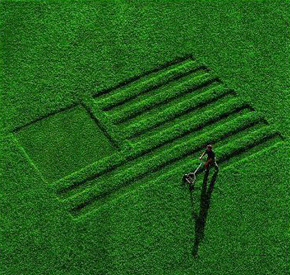
The Lawn has Become as much of an American Icon as Baseball and Apple Pie. But at What Cost? (Photo credit: From the cover of “The American Lawn” by Georges Tevssot)
Since 1948, radio station KBMW has been serving as the “Voice of the Southern Red River Valley,” a tri-state area including North Dakota, South Dakota and Minnesota, boasting some of the “richest farmland in the United States.” So why did they want to interview a city boy who lives for salt water? To update their listeners on the BP oil spill disaster in the Gulf of Mexico, and most importantly, tell their listeners how they could help. Like so many of us, they feel a deep connection to the Gulf, even from more than 1,200 from water’s edge, and the daily images of oil erupting from the BP well has led to palpable frustration. It’s hard to watch and not be able to help. Truth is, KBMW’s listeners are more connected than they may realize, and they can materially help the Gulf of Mexico — and their own neighborhoods, by just getting outside and doing some gardening.
Recently the news went from bad to worse in the Gulf when it was discovered that tremendous volumes of natural gas (methane) were being released along with oil into the Gulf, several times more than would typically accompany such a gusher. Some of the methane bubbles up to the surface and enters the atmosphere, but much of it dissolves into the water. Researchers recently discovered areas in the water column where methane levels were 10,000 times normal.
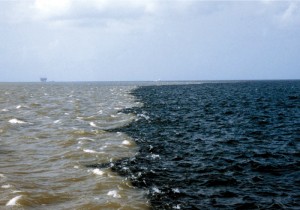
A dead zone the size of the state of New Jersey lies in the Gulf of Mexico near the mouth of the Mississippi River. Here water from the Mississippi, laden with sediments, organic material, nutrients and pesticides, enters the Gulf of Mexico (Photo: EPA/N. Rabalais, Louisiana Universities Marine Consortium)
The good news is that there are naturally-occurring bacteria that eagerly break down methane. The bad news is that the process of breaking down methane, oil, or other organic materials requires oxygen and already scientists discovered oxygen levels in the area at less than a quarter of what they should be. This means that these reaches of the Gulf have suddenly become hostile to organisms that need oxygen to survive — organisms like fish, which use their gills to extract dissolved oxygen from the water. When the water becomes so hypoxic (low oxygen) or anoxic (no oxygen) that it can’t support life, it’s called a “dead zone,” and the months-old eruption of oil and gas is robbing precious oxygen from the animals of the Gulf that need it. It gets worse. The problem is, there already is a dead zone in the Gulf of Mexico near the mouth of the Mississippi, and it’s massive. It’s the second largest dead zone in the world: The size of the state of New Jersey.
The problem is that we’re dumping tons of organic waste into the Gulf of Mexico, along with tons of fertilizer (nitrogen and phosphorous) and pesticides from the farms of the heartland and the lawns of suburbia. Forty percent of the continental United States drains into the Mississippi Basin, which empties into the Gulf of Mexico.That includes 38 U.S. states (including KBMW’s listeners in the Dakotas and Minnesota) along with the Canadian provinces of Alberta and Saskatchewan. But the nutrient problem doesn’t end there — it’s also coming from the other U.S. states with Gulf of Mexico waterfront, namely Texas, Mississippi, Alabama and Florida, not to mention the 5 Mexican states and 5 Cuban provinces that border on the Gulf.
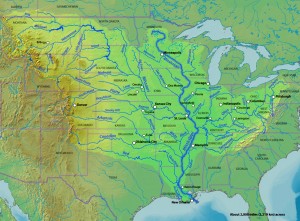
Forty percent of the continental United States (portions of 38 states and 2 Canadian provinces) drains into the Mississippi River Basin, which empties into the Gulf of Mexico.
Those fertilizers do the same thing in the Gulf of Mexico that they do on farms, your back yard, or in the planter in your den: They stimulate plant (and algae) growth. In the Gulf, this means enormous algae blooms, and once those algae die and are broken down by bacteria, oxygen levels plummet. Combined with the massive volumes of oil and gas being discharged into the Gulf, oxygen may become a rare commodity…as may fish and other marine wildlife. Not only is oil and gas adding to the already heavy load of organic material in the water, but oil slicks at the surface can prevent oxygen from dissolving into the water column in the first place by essentially forming an impenetrable barrier.
As you can imagine, trying to fix the dead zone is an effort that presents an enormous challenge that encompasses tens of millions of acres of land and crosses every imaginable type of jurisdictional border. And it draws focus on how we use our lands, what we grow, what we put on the land, and what runs off. And this is where you and I come in, because it turns out the the largest irrigated crop in America is not corn, nor wheat, nor barley, nor soy. According to the journal Environmental Management, some 40 million acres of America are covered in lawns, making turf grass our largest irrigated crop.
Americans pour as much as 238 gallons of water per person, per day onto lawns during the growing season. Each year we use tens of millions of pounds of fertilizers, insecticides and weedkillers used on our lawns, not to mention the 800 million gallons of gasoline we burn in lawnmowers each year. Outdoor watering accounts for more than half of municipal water use in most areas, and homeowners often apply fertilizers and pesticides to their lawns at many times the recommended levels.
The American obsession with a green lawn took root in mid-19th century, with an eye to Europe’s long-standing practice. Nearly two centuries later, the words of landscape designer Frank J. Scott, written in 1870, are still firmly rooted in the American psyche: “A smooth, closely shaven surface of grass is by far the most essential element of beauty on the grounds of a suburban house.” The lawn has become a social barometer, signifying wealth and class, an iconic suburban manifestation of keeping up the Jones’. Even if you don’t care to compete with your neighbor for the greenest lawn, in many localities you have a civic duty to maintain a well-manicured lawn or face the risk of being slapped with a fine.
“A smooth, closely shaven surface of grass is by far the most essential element of beauty on the grounds of a suburban house,” Frank J. Scott, Landscape Designer
It’s not that lawns don’t provide benefits. They’re nice to look at, smell nice, produce oxygen and pull carbon dioxide from the air. The problem is, it comes at a cost, and most of us only use a small fraction of the lawns we work so hard to maintain. Fortunately, there is an alternative that will help your yard, your community, your wallet, and yes, the Gulf of Mexico.
Near the end of my tenure as president of The Conservancy of Southwest Florida, I planned to launch a new campaign, to which I dubbed the playful if not partially accurate working title, the “Kill Your Lawn Campaign.” I planned to take a shovel to the lawn of my home in Naples and replant most of it using native vegetation. Thanks to a wonderful program in Florida called, “Florida Yards & Neighborhoods” (part of the Florida-Friendly Landscaping Program through the University of Florida/IFAS Extension Service and the Florida Department of Environmental Protection) I could receive training and advice on how to go about replanting with native vegetation, choose the right vegetation, etc. The benefits of using native vegetation seemed endless: Little or no watering, fertilizing, pest control. A lush, natural landscape that attracts wildlife, including butterflies and birds. And for the local water bodies, including the Gulf of Mexico, my yard wouldn’t be contributing to the nutrient load. On top of all of that, water conservation is a critical part of protecting and restoring the Everglades. It never made any sense to me that we would pump the Everglades dry to irrigate lawns in the middle of that magnificent ecosystem. As it turned out, I moved from Naples to a downtown DC condo before I could implement the plan, but should I ever live in suburbia again, the lawn has to go.
There are programs like Florida Yards & Neighborhoods across the country. Your state or local government may have resources at little or no cost that you never knew about. I was invited to speak later this year at the Licking County Soil and Water Conservation District in Newark, Ohio. They work hard to provide information to homeowners and landowners to use their land responsibly while protecting the County’s water resources. You may be lucky enough to have such a resource in your county.
2010 marks the 75th anniversary of the Natural Resources Conservation Service (NRCS) and the beginning of the federal commitment to conserving natural resources on private lands. Originally established by Congress in 1935 as the Soil Conservation Service (SCS), NRCS has expanded to help ensure that private lands are conserved, restored, and more resilient to environmental challenges, like climate change. There are field offices at USDA Service Centers in nearly every county in the Nation.
Although the majority of fertilizers and pesticides entering the Gulf come from farms, better managing the land where our homes sit can also make a significant difference. Perhaps “Kill Your Lawn” is an extreme many aren’t ready or willing to do, but here are a few tips you might consider:
-
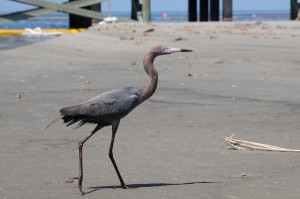
Helping the Gulf of Mexico begins in your back yard – literally. An oiled reddish egret near the water in Grand Isle, La (Photo credit: Petty Officer 3rd Class Patrick Kelley, USCG)
Get in touch with your local Soil and Water Conservation District and/or USDA Extension Service office and learn the best land management techniques for your area
- Reduce the size of your lawn and replant with native vegetation
- Practice environmentally-friendly techniques in your yard. Try to water less and follow fertilizer and pesticide instructions carefully. If you use a lawn service, consider hiring one that uses more environmentally-friendly practices, such as NaturaLawn (not an endorsement)
- If you need to pave your driveway or deck, use permeable concrete or stone so water doesn’t simply run off when it rains
For many, helping the Gulf of Mexico Starts in your back yard — literally. For the rest, the Atlantic, Pacific and Great Lakes and other great water bodies of the world thank you. According to KBMW, today’s forecast calls for a high of 79 degrees with a blend of clouds and sun. Winds NW 10-20 mph, breezy at times. Perfect gardening weather.
Learn more:
Florida Yards & Neighborhoods Program
Audubon’s Mississippi River Initiative

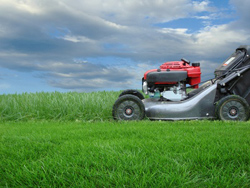
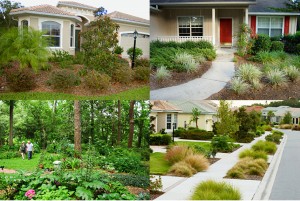
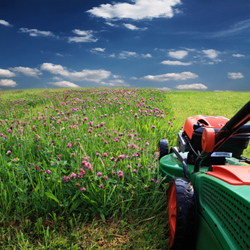
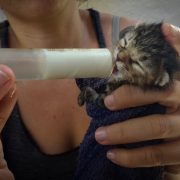
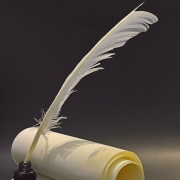
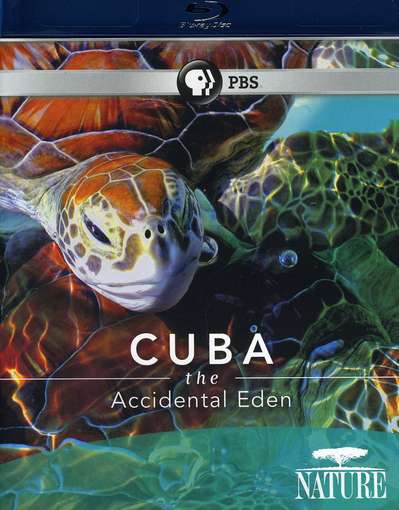

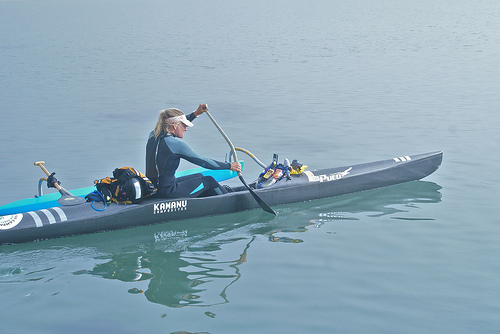
I live in NY state…hat mowing the lawn. would love to replace grass with natural ..have 4 kidas love to play in yard. what suggestions might you ahve to aquire this ?
This is a great article!!! For anyone looking for local help on native plants, rain barrels, soil testing, stormwater runoff, and other conservation practices, please contact your local soil and water conservation district. Here is a website that will help you find a SWCD in your area http://nacdnet.org/about/districts/locate/
@Deborah
Deb- You might want to consider artificial turf. It looks substantially better than it used to (not green looking carpet… lol) and depending on how much you water your lawn, it will eventually pay for itself-
Yes Doc,
I completely agree with you that with obsessions of Lawns in front of our houses not only is wastage of water , fuel ,money but more importantly taking away the lives of dumb animals.
I think so municipal government should come up with Acts to control the Lawn built up area in front of houses.
If this not done fast then a major imbalance would be created in tne environmental cycle